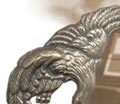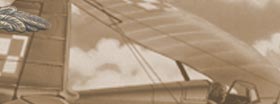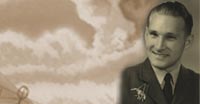














|
|
Major-General Stanislaw Sosabowski, C.B.E
Major-General Sosabowski's early years in Stanislawow in south-eastern Poland
were tough. His mother was widowed when he was twelve years of age and the family
slowly slid into poverty despite a very small state pension. To help ends meet,
he provided private French and maths tuition to less able fellow classmates for
a modest fee. To complete his own studies, he borrowed books while they played.
His refusal to invest in books or even a proper winter overcoat enabled his younger
brother Andrew and sister Julia to be fed and have adequate heating during the
winter. His formidable reputation as a tutor was such that his own teachers would
recommend him to parents whose children were unruly or backward. In his own words,
'I was very hard on my pupils and kept them at their books until they solved the
problems' (Sosabowski, 1960:14).
Stanislawow was only about 30 miles from the beautiful Carpathian Mountains where
he taught himself to climb, ski and survive in the open countryside. Before the
First World War Stanislawow was under the shackle of the Austrian Empire and young
Sosabowski disliked foreign rule and had joined the Polish Underground at the
age of fourteen and was to lead a school group. In 1908 these units became armed
and called 'Polish Rifle Units'. By 1911, Sosabowski had passed stiff military
exams and given his first commission of commanding the Stanislawow unit against
the Austrians.
In 1914 Austria conscripted all 'fit' Poles and put them in Austrian uniforms
and marched them off to fight young Poles in Russian uniforms. Prevented from
joining Pilsudski's Polish Legion, Sosabowski saw military action in October 1914
when as a corporal became surrounded by the Russians at the Austrian town of Przemysl.
Mortars and artillery blasted the trenches while rifle and machine-gun fire sealed
any escape. The horror of the carnage and the collapse of military and civil systems
into a brutal chaos remained with him and gave him a clear understanding of the
differences between power and the obligation of commanders towards his men. Slowly
promoted through the ranks, his first year of the war saw only 3 survive out of
250 Poles and Ukrainians in his unit. His experience learnt in field-craft through
the battle filed was used to help save both poorly trained officers and men. By
the end of the war, he had been promoted to second lieutenant and had observed
the disarmament of the Austrians who had commanded him and assisted in the formation
of the Polish Army for the war against the Bolsheviks.
Major-General Sosabowski's account of his own escape is untypical of the period,
but shows how during the early part of the war, communication and transport systems
were able to 'spirit away' leading figures to assist in the re-grouping of units.
On the 28th September 1939 Sosabowski was based in Praga and was commanding the
21st Children of Warsaw Brigade. Poland was in a state of collapse and the Germans
had issued their eight-point conditional surrender. Despite numerous casualties,
the troops under his command maintained their resolve and loyalty to Sosabowski.
Unlike air force units who had moved eastwards, many field units lacked mobility.
At this stage, the Poles were also unaware of the Ribbentrop-Molotov Pact and
so the possibility of fighting through German lines would be short lived.
Sosabowski was determined not to concede defeat and enter a prisoner of war camp.
Disinformation about his whereabouts and the idea of a faked suicide was considered
to deceive the Germans. With a few personal possessions and rebuking advise from
senior officers who had decided to surrender, he set off for home. However, he
decided to rejoin his unit and lead them into captivity were lower ranks might
obtain their discharge papers from the Germans. The march into captivity must
have been miserable as the remnants of other units joined them as they marched
through the broken ruins of Warsaw. The German attitude to the captured Poles
re-ignited his decision to escape. The next few days were spent evaluating an
escape route. In the end civilian clothes were stashed in a local hospital. An
army doctor advised using lumbago as a cover for a trip for further medical investigation
and treatment.
The ruse worked and with inside help from the caretaker slipped away. Papers were
obtained and Sosabowski caught a packed evening train out of the city. The train
got as far as Pruskow on the outskirts of Warsaw because of the curfew. The last
leg of the journey home to Zoliborz was on foot where he could contact friends
who had a wide range of contacts including the Polish Underground
(Home Army).
Sosabowski was all too familiar with the workings of running a covert underground
operation. His initial tasks were to set up cover jobs for operatives. His own
success in finding a job met a wall of resistance as he was too well known and
possibly endangered those who publicly assisted.
Forged papers describing him as a motor salesman employed at Lodz provided a basic
cover so that he could obtain travel permits. At Lodz he found the city being
Germanized (Volksdeutsch) with changes in street names to pander (or 'honour')
the Nazi hierarchy. Other trips within the annexed zone also included a trip ordered
by the commander of the Home Army, General Rowecki, to collect funds from Romania
by travelling through the Russian zone. As the country settled in to occupation
within the General Government, the Home Army began building rudimentary networks
with the minimum of resources.
Sosabowski's escape was a high risk and a tortuous route via the Russian zone.
After operating out of Lodz, he temporarily returned home where he prepared for
his escape. His officer's sabre was buried in the back garden and said his farewells
to family. (His son, Stas never made it across the southern escape routes through
the Tatry Mountains, but fought with distinction during the Warsaw Uprising in
19944). On arrival in Lublin, the Gestapo had made a number of key arrests within
the network and despite the damage; he managed to deliver orders from Wars. Lublin
was well known to Sosabowski who had served there before the war; however, few
friends were in a position to help him over the border into the Russian Zone.
A train ride took him to Belzec on the border. Again, contact with the 'Movement'
was curtailed by surveillance of likely activists. After dark, a peasant took
Sosabowski and another refugee over the border by dodging both Russian and German
patrols through a moonlit countryside. Arrival at a village should have enabled
the next stage of the journey to be completed in a horse and cart to the railway
station at Werchrata to catch the Lwow train. Unfortunately, their guide let them
down and another guide was bought after some haggling for the journey. The new
guide succeeded in losing the path in the snow and abandoned them to their fete.
A Ukrainian woman redirected them and they set off in the lightly falling snow.
A horse-rider appeared out of the ground mist and blocked their path. He explained
the route to Rawa-Ruska was a waste of time, as they would most certainly be caught.
Again, a fee was haggled and after a meal and rest set off through the night and
snow covered countryside.
Lwow was a heaving mass of Jews and Poles who had fled the Nazis intermingled
with Ukrainians and Russians. While the Russians fraternised with their subjugated
subjects, there still remained strict control in the movement of people. To avoid
pass controls, he alighted the train at Podzamcze and set off to his next contact.
Lwow had been transformed into the Soviet system. Red flags and martial music
interspersed with political rhetoric proclaiming Stalin as the saviour greeted
him at every street corner. The People's Policemen were in evidence too. Again,
like Lublin, contacts had gone to ground and found it difficult to get help. The
local Movement leader, General Januszajtis had been imprisoned and a delegation
that had set off to meet with General Sikorski in Hungary, never arrived. For
the next few days, Sosabowski rested and made small deliveries of letters to the
Red Cross while waiting for news or new instructions. Word reached Sosabowski
that General Anders was in hospital in Lwow and would be pleased to receive visitors.
The decision not to visit him turned out to be fortuitous as Anders was later
to be interrogated as Stalin sent thousands of Polish personnel to the Gulags.
The underground movement in Lwow was in disarray with many members arrested and
activity now would have harmed what remained of the cells within the network.
Sosabowski took a reconnaissance trip home to Stanislawow on the 3rd December
1939 to see if there were alternative routes out of the Russian Zone. The trip
was a waste of time, but he had managed to slip home without being recognised.
On December 6th 1939, a woman courier arrived from Warsaw. Messages and ciphers
were swapped for details of the escape to Budapest. With changes in identity,
Sosabowski left Lwow for Drohobycz on the 7th December and escape through the
oilfields. Again, on arrival a swift transfer to safe houses and changes in guides
ensured network security and survivability of individuals. Another train ride
took them to Boryslaw where their contact worked in the oilfields and whose accommodation
had been commandeered for the Communist Youth Club - an ideal cover. The next
day they set off on foot with a new guide and walked through the oilfields towards
Schodnica where they were almost captured by a Russian patrol while trying to
eat a meal. The place was too dangerous, so the local priest hid them while Sosabowski
waited further instructions. They left that night by following a rail-track through
the forest towards Majadan. Now armed with a pistol and white bed linen to camouflage
them in snow, they were close to completing the hardest part of the route. As
they followed the rail-tracks, either another patrol or group of fellow escapers
passed closely to where they hid in the forest. At Majadan, their guide Maria
had to return and accept no payment for the trip. Patriotism had sustained the
young woman.
Mid-day brought new guides for the leg towards Smorze and the Hungarian border.
One guide fell ill and the other almost abandoned his charges in the middle of
the forest and so tantalisingly close to success. After much protesting, the guide
left Sosabowski on the outskirts of Smorze. Armed with a compass, Sosabowski and
his unnamed companion set off for the border. They carried out a reconnaissance
and discovered from their forest hideout that a road ran parallel to the river
Stryj that was bordered by a large flat flood plain offering little cover. Crossing
points were easy to discern. However, a man dressed in country clothing and walked
towards him spotted Sosabowski. Sosabowski's companion hid deeper in the forest
while the newcomer was interrogated. It turned out to be another escapee whose
party had been intercepted by a Soviet patrol and shot at. He had escaped and
had guessed Sosabowski was attempting a crossing. They remained hidden in the
forest for the remainder of the day and began to suffer from hypothermia as the
wind got up. They successfully found a crossing point close to where the forest
met the road. The river was only partially frozen and required the escapees to
strip and tie their clothes above their heads. The ice broke and they dashed through
the shallows until they reached the opposite bank. Shivering, they tried desperately
to warm themselves. As darkness had fallen, the wind had dropped and clouds scudded
over the moon. In the stillness of the night the trio were conscious how far sound
travelled. It is an experience none of them would ever forget. Hungary lay a few
hundred yards over the brow of a steep wooded hill. The river Latorcza was the
final hurdle. After resting in a haystack and eating what was left of their rations,
they slept fitfully or whiled away the time. At nightfall, the trio set off. Suddenly
it dawned on Sosabowski that they had crossed a loop in the Stryj and were still
in Poland. On retracing their steps they had enough time to hysterically laugh
at their error. Finally, they crossed into Hungary at Latorcza and reported to
the local police.
Hungarian soldiers escorted them to the larger village of Verecko. Officials questioned
the trio and the Sosabowski revealed the true purpose of his visit. Half an hour
later they were put on a bus with an escort bound for Budapest and the Embassy.
While the rest of the journey was not event free, the final leg was in comparative
speed and comfort than the fate of so many others. Sosabowski worked with unquestionable
devotion to securing freedom for Poland in numerous ways.
His exemplary courage while commanding the Polish Independent Parachute Brigade
at Arnhem has been well documented.
Top of Page
|
|





